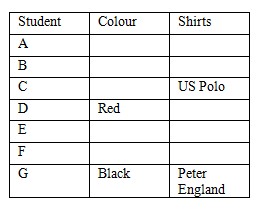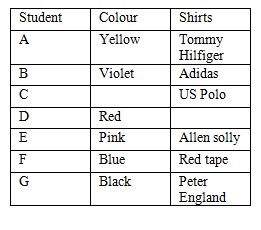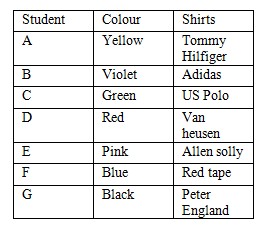Question
Which of the following combination is
correct? Study the following information and answer the given questions: Seven students A, B, C, D, E, F and G bought different shirts – Allen solly, Tommy Hilfiger, Van heusen, Peter England, US Polo, Adidas and Red tape of different colours – red, blue, green, yellow, pink, black and violet but not necessarily in the same order. (i) C bought US Polo shirt but not of the colour yellow or pink. (ii) D bought red colour shirt but not of the brand Tommy hilfiger or Adidas. (iii) G bought Peter England shirt of black colour. The one who bought Red tape shirt is of blue colour. (iv) E bought Allen solly shirt, B have violet colour shirt, A did not bought Red tape. (v) The one who bought yellow colour shirt have the brand Tommy hilfiger.Solution
From (i), (ii), (iii) we get, C bought US Polo shirt but not of the colour yellow or pink. D bought red colour shirt but not of the brand Tommy Hilfiger or Adidas. G bought Peter England shirt of black colour.  From (iii), (iv) and (v) we get, E bought Allen solly shirt, B have violet colour shirt, A did not bought Red tape. The one who bought yellow colour shirt have the brand Tommy Hilfiger. The one who bought Red tape shirt is of blue colour. A did not bought Red tape shirt, this means F bought Red tape shirt of blue colour. C did not like yellow and pink colour, this means E likes Pink colour. D did not have the brand Tommy Hilfiger or Adidas, so B is having Adidas brand.
From (iii), (iv) and (v) we get, E bought Allen solly shirt, B have violet colour shirt, A did not bought Red tape. The one who bought yellow colour shirt have the brand Tommy Hilfiger. The one who bought Red tape shirt is of blue colour. A did not bought Red tape shirt, this means F bought Red tape shirt of blue colour. C did not like yellow and pink colour, this means E likes Pink colour. D did not have the brand Tommy Hilfiger or Adidas, so B is having Adidas brand.  Now the final arrangement is:
Now the final arrangement is: 
In BGP path selection, which attribute is considered first?
Which of the following shows the count of arguments passed to the script?
Which component is responsible for translating virtual addresses to physical addresses?
Which keyword is used to throw an exception explicitly?
What is the purpose of the Program Counter (PC) in CPU control design?
Which of the following is a characteristic of a public blockchain?
In public key cryptography, which key is used for encryption?
State true or false.
Is it possible that the assignment of observations to clusters does not change between successive iterations in K-Means?
What does HTML stand for in web technology?
Which type of memory can be both read from and written to by the processor?
Relevant for Exams:


